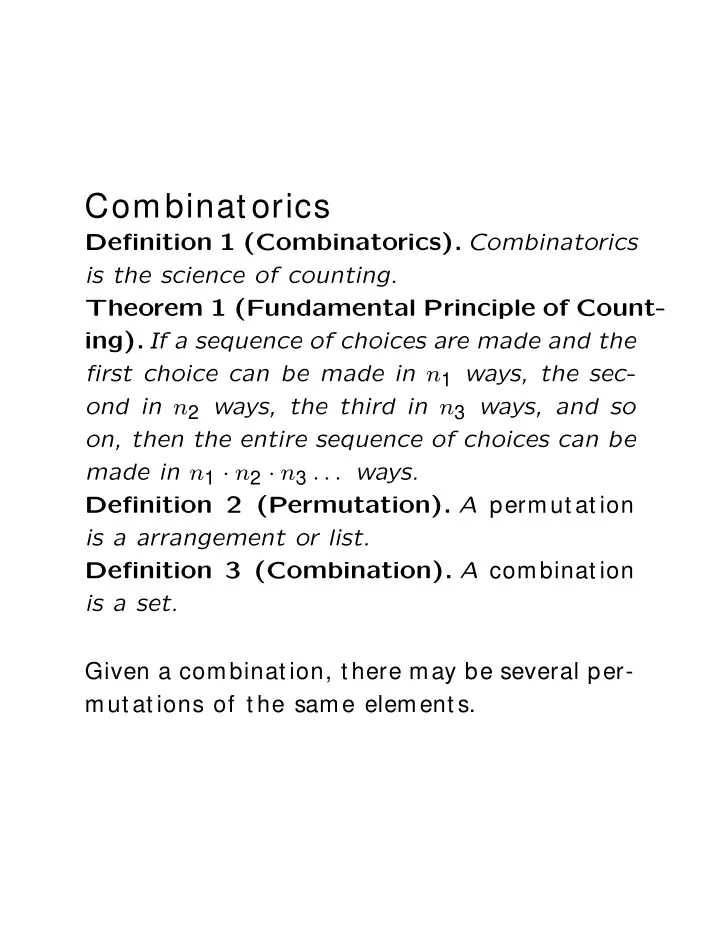

Combinat orics Definition 1 (Combinatorics). Combinatorics is the science of counting. Theorem 1 (Fundamental Principle of Count- ing). If a sequence of choices are made and the first choice can be made in n 1 ways, the sec- ond in n 2 ways, the third in n 3 ways, and so on, then the entire sequence of choices can be made in n 1 · n 2 · n 3 . . . ways. Definition 2 (Permutation). A permut at ion is a arrangement or list. Definition 3 (Combination). A combinat ion is a set. Given a combinat ion, t here may be several per- mut at ions of t he same element s.
Example: T he set { a, b, c } yields t he following permuat ions: a,b,c a,c,b b,a,c b,c,a c,a,b c,b,a W e may refer t o permut at ions wit h or without replacement . In a permut at ion with replace- ment , t he same element may appear more t han once. In a permuat ion without replacement , no element may appear more t han once. Theorem 2. The number of permutations wit h of length r of elements chosen replacement from a set of size n is n r . T his t heorem is almost obvious from t he Fun- damental Principle of Counting .
Notation. The number of permutations wit h- out replacement of length r of elements chosen from a set of size n is denoted by P ( n, r ) . Alt ernat e not at ions which may be found in ot her sources: P n,r , n P r . Theorem 3. P ( n, r ) = n ! n ( n − 1) ( n − 2) · · · ( n − [ r − 1]) = ( n − r ) ! . Here, k !, read k factorial , means k ( k − 1) ( k − 2) · · · 3 · 2 · 1. In ot her words, k ! is t he product of all t he posit ive int egers between 1 and k . k must be an integer!
Notation (Combinations). The number of com- binations of r elements chosen from a set of size n is denoted by C ( n, r ) . Alt ernat e not at ions which may be found in ot her � n � sources: C n,r , n C r , . r W e somet imes refer t o C ( n, r ) as n choose r , since it may be t hought of as t he number of ways of choosing r object s from a set of size n .
n ! Theorem 4. C ( n, r ) = r !( n − r ) ! . Proof. Each combinat ion of r element s gives rise t o P ( r, r ) diff erent permut at ions of t he same element s. T hus, t he number of permu- t at ions of size r is P ( r, r ) t imes t he number of combinat ions of t he same size. It follows t hat P ( n, r ) = C ( n, r ) P ( r, r ) . Since n ! r ! P ( n, r ) = ( n − r ) ! and P ( r, r ) = 0! = r !, it follows t hat C ( n, r ) = n ! / ( n − r ) ! n ! = r !( n − r ) !. r ! Example: T he number of Gin Rummy hands 52! is C ( 52 , 10) = 10!42!.
Recommend
More recommend